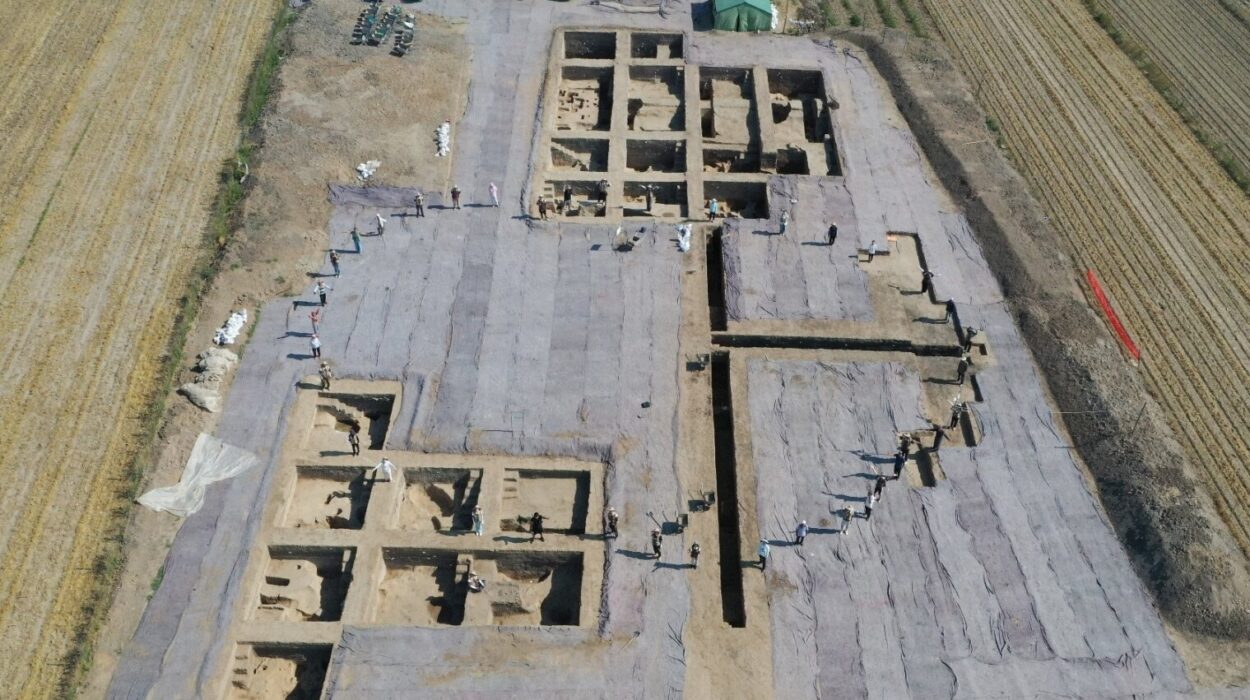Around 5,000 years ago, a shadow fell over Eurasia. A mysterious form of plague began spreading through human populations from the edges of Europe to the depths of Central Asia. Unlike the medieval Black Death that would devastate Europe millennia later, this ancient strain—now known as the Late Neolithic and Bronze Age (LNBA) plague—was different. It lacked the genetic toolkit for flea-borne transmission that defines the modern disease. Its method of spread was a riddle, and its origin remained elusive. Then, about 2,000 years after it appeared, it vanished entirely.
For decades, the LNBA plague was known only from ancient human DNA. Scientists suspected it had zoonotic origins—meaning it likely jumped from an animal host to humans—but no one had ever found direct evidence of the disease in an animal. That is, until a remarkable discovery at a windswept archaeological site in the Western Eurasian Steppe provided the missing link.
A Sheep’s Bones, and a Long-Lost Genome
At Arkaim, a Bronze Age settlement belonging to the Sintashta-Petrovka culture, archaeologists unearthed the remains of a domesticated sheep, buried in soil that had lain undisturbed for 4,000 years. When researchers from the Max Planck Institute of Infection Biology, Harvard University, the University of Arkansas, the Max Planck Institute of Evolutionary Anthropology, and Seoul National University analyzed the animal’s DNA, they made an extraordinary find: this sheep carried the same LNBA strain of Yersinia pestis—the bacterium that causes plague—that had been infecting humans in the region at the same time.
It was the first time the prehistoric plague had been identified in livestock. And it brought scientists one step closer to understanding how the disease could have persisted across thousands of kilometers for millennia without the help of rats and fleas.
Sheep, Pastures, and Pathogen Pathways
The Sintashta-Petrovka people were not farmers in the traditional sense. They were pastoralists, herding cattle, sheep, and horses across vast open pastures. Unlike the grain-storing societies of the ancient Near East, their settlements offered little to attract rodents—the classic plague carriers. Yet human remains from the culture had tested positive for LNBA plague before. Now, with the discovery of an infected sheep, the pieces of the puzzle began to fit.
“Sheep could have been a critical bridge between the wild reservoir of plague and human communities,” explains Dr. Christina Warinner of Harvard University, who co-led the study. “They roamed far, grazed in areas where wild animals lived, and could have picked up the bacterium through direct contact with infected carcasses. From there, it was only a short step into humans.”
Modern parallels support this theory. In regions where plague still exists today, sheep sometimes become infected after encountering infected rodents, and improperly handling or eating such sheep can trigger human outbreaks.
The Search for the Reservoir
Even with this breakthrough, the wild reservoir that hosted the LNBA plague remains unknown. Unlike today’s Y. pestis strains, which show distinct regional differences, the ancient LNBA lineage appears strangely uniform across distances of up to 6,000 kilometers. This suggests the pathogen may have been repeatedly spilling over from a stable animal population, rather than spreading in a continuous chain of human-to-human or animal-to-animal transmission.
Genetic analysis revealed something even more unusual: the ancient strain seemed to be evolving under heavy constraints. Certain genes mutated repeatedly and independently across different samples—patterns that researchers believe could be the genetic fingerprints of past spillovers from its reservoir species.
“This tells us the plague wasn’t freely circulating among humans or livestock,” says Dr. Felix M. Key, senior author of the study. “It was jumping from its hidden host again and again. Finding that host is the next big challenge.”
A Disease on the Move
One of the enduring mysteries is how the LNBA plague could appear almost simultaneously in places thousands of kilometers apart. Sick humans and livestock could not have traveled such vast distances quickly enough to account for the genetic similarities between far-flung samples. This hints at an unknown factor—possibly migratory wildlife—that moved the disease far more efficiently.
The study underscores just how much of prehistoric disease ecology remains a blank page. Until now, most ancient DNA work on plague has focused on human remains. But ancient animal bones, thousands of which sit in museum and excavation storerooms, may hold untapped evidence about how pathogens evolved and spread.
Why It Matters Today
Understanding the dynamics of ancient plagues is more than a matter of historical curiosity. Over 60% of human infectious diseases today have zoonotic origins, and many—like COVID-19—emerged because humans came into closer contact with animal hosts. The domestication of livestock during the last 10,000 years dramatically increased these interactions, providing countless opportunities for pathogens to cross species boundaries.
“The LNBA plague shows that livestock weren’t just passive bystanders in ancient disease history,” says lead author Ian Light-Maka. “They could have been active participants in maintaining and transmitting deadly pathogens.”
By tracing the plague’s ancient journey through both humans and animals, researchers hope to shed light on the environmental, cultural, and biological factors that make certain diseases so successful at spreading—and perhaps, how to prevent future spillovers from turning into pandemics.
A Step Closer to an Ancient Killer
The discovery at Arkaim doesn’t solve the mystery of the LNBA plague’s origin, but it offers a crucial clue: domesticated animals like sheep may have been more than just companions and sources of food for Bronze Age people—they may have been unwitting partners in one of the most enigmatic disease outbreaks in human history.
As scientists prepare to analyze more animal remains from ancient sites, they hope to fill in the missing links between humans, livestock, and the wild reservoir that once harbored the prehistoric plague. Until then, the bones of a 4,000-year-old sheep stand as silent testimony to a forgotten chapter in humanity’s long, intertwined history with disease.
More information: Bronze Age Yersinia pestis genome from sheep sheds light on hosts and evolution of a prehistoric plague lineage, Cell (2025). DOI: 10.1016/j.cell.2025.07.029. www.cell.com/cell/fulltext/S0092-8674(25)00851-7






